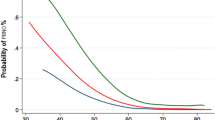Abstract
The aim of this study was to determine whether the evaluation of lower urinary dysfunction with urodynamics and urethrocystoscopy provides unique information that is missed by urodynamics alone. Eighty-four women underwent multichannel urodynamics and urethrocystoscopy. Retrospective analysis included evaluation of the relationships between lower urinary tract lesions and risk factors using χ2 and Fisher's exact tests. Urethrocystoscopic findings changed the diagnosis and managment in 6 patients. New urethrocystoscopic findings included papillary transitional-cell carcinoma, cystitis glandularis, an intravesical suture and a urethral diverticulum. Clinical parameters were not predictive of these findings. Urethrocystoscopic findings also contributed to the final diagnosis in 10 patients with intrinsic sphincter deficiency. Considered alone, maximum urethral closure pressure ≤20 cm H2O had a sensitivity of only 20% and a positive predictive value of 40% for this diagnosis. Urodynamics without urethrocystoscopy would have missed important diagnoses in 19% of women. Urethrocystoscopy and urodynamics complement one another, and both have a role in the evaluation of women with lower urinary tract dysfunction.
Similar content being viewed by others
References
Walters MD, Shields LE. The diagnostic value of history, physical examination, and the Q-tip cotton, swab test in women with urinary incontinence.Am J Obstet Gynecol 1988;159:135–149
Robertson JR. Air cystoscopy.Obstet Gynecol 1968;32:328–330
Robertson JR. Gynecologic urethroscopy.Am J Obstet Gynecol 1973;115:986–990
Sand PK, Hill RC, Ostergard DR. Supine urethroscopic and standing cystometry as screening methods for detection of detrusor instability.Obstet Gynecol 1987;70:57
Scott RJ, Ostergard DR, Guillaume AA, Kohatsu KE. Predictive value of urethroscopy as compared to urodynamics in the diagnosis of genuine stress incontinence.J Reprod Med 1990;35:772–776
Abrams P, Blaivas JG, Stanton SL, Anderson JT, The International Continence Society Committee on Standardization of Terminology. The Standardization of terminology of lower urinary tract function.Scand J Urol Nephrol 1988;114S:5–20
Bergman A, Koonings PP, Ballard CA. Proposed management of low urethral pressure type of genuine stress urinary incontinence.Gynecol Obstet Invest 1989;27:155–159
Sand PK, Bowen LW, Panganiban R, Ostergard DR. The low pressure urethra as a factor in failed retropubic urethropexy.Obstet Gyencol 1987; 69:399–402
Daroca PJ, McKenzie F, Reed RJ, Keane JM. Primary adenovillous carcinoma of the bladder.J Urol 1976;115:41–45
Edwards PD, Hurm RA, Jaesehke WH. Conversion of cystitis glandularis to adenocarcinoma.J Urol 1972;108:568–570
Susmano D, Rubenstein AB, Dakin AR, Loyd FA. Cystitis glandularis and adenocarcinoma of the bladder.J. Urol 1971;105:671–674
Young JL Jr, Percy CL, Asire AJ (eds) Surveillance, epidemiology, end results: incidence and mortality data, 1973–77.Natl Cancer Inst Mongr 1981;57:1–1082
Anton-Culverd H, Lee-Feldstein A, Taylor TH. Occupation and bladder cancer risk.Am J Epidemiol 1992;136:89–94
Silverman DT, Hartage P, Morrison AS, Devesa SS. Epidemiology of bladder cancer.Hematol Oncol Clin North Am 1992;6:1–30
Leach GE, Bavendam TG. Female urethral diverticula.Urology 1987;30:407–415
Robertson JR. Urethral diverticula. In Ostergard DR, Bent AE, eds. Urogynecology and urodynamics: theory and practice, 3rd edn. Baltimore: Williams & Wilkins, 1991:283–291
Drutz HP. Urethral diverticula.Obstet Gynecol Clin North Am 1989;16:923–929
Summitt RL, Stovall TG. Urethral diverticula: evaluation by urethral pressure profilometry, cystourethroscopy, and the voiding cystourethrogram.Obstet Gynecol 1992;80:696–699
Urinary Incontinence Guideline Panel. Urinary incontinence in adults: clinical practical guidelines. AHCPR Pub. No. 92-0038. Rockville, MD: Agency for Health Care Policy and Research, Public Health Service, US Department of Health and Human Services, March 1992
Decter RM, Harpster L. Pitfalls in determination of leak point pressure.J Urol 1992;148:588–591
Richardson DA, Ramahi A, Chalas E. Surgical management of stress incontinence in patients with low urethral pressure.Gynecol Obstet Invest, 1991;31:106–109
McGuire EJ, Lytton B, Pepe V, Kohorn EI. Stress urinary incontinence.Obstet Gynecol 1976;47:255–264
Bergman A, McKenzie CJ, Richmond J, Ballard CA, Platt LD. Transrectal ultrasound versus cystography in the evaluation of anatomical stress urinary incontinence.Br J Urol 1988;62:228–234
Chang HC, Chang SC, Kuo HC, Tsai TC. Transrectal sonographic cystourethrography: studies in stress urinary incontinence.Urology 1990;36:488–492
Gordon D, Pearce M, Norton P, Stanton S. Comparison of ultrasound and lateral chain urethrocystography in the determination of bladder neck descent.Am J Obstet Gynecol 1989:160:182–185
Kohorn EI, Scioscia AL, Jeanty P, Hobbins JC. Ultrasound cystourethrography by perineal scanning for assessment of female stress urinary incontinence.Obstet Gynecol 1986;68:269–272
Weil EHK, van Waalaijk van Doorn ESC, Heesakkers JPFA, Meguid T, Janknegt RA. Transvaginal ultrasonography: a study with healthy volunteers and women with genuine stress incontinence.Eur Urol 1993;24:226–230
Author information
Authors and Affiliations
Additional information
EDITORIAL COMMENT: Urethrocystoscopy as an integral part of urinary incontinence evaluation was popularized by Dr Robertson in the early 1970s. With the appearance of the sensitive microtip pressure transducers and multichannel urodynamics, these modes of evaluation became the gold standard. The popularization of urodynamic studies has put a question mark against the role of cystourethrscopy in evaluating incontinence. This study provides important information on the role of urethrocystoscopy in addition to urodynamic studies. The change of managment based on endoscopic findings in 19% of women in this series, is the answer. One disturbing finding in this report is the very high incidence (5%) of cancer or precancer in women with urinary incontinence. Many urogynecologists do not find 1 in 20 of their patients having cancer or precancer of the lower urinary tract, except perhaps for referral centers for oncologists. Still we should keep these number in mind and look for bladder abnormalities when performing endoscopic studies in the evaluation of urinary incontinence.
Rights and permissions
About this article
Cite this article
Cundiff, G.W., Bent, A.E. The contribution of urethrocystoscopy to evaluation of lower urinary tract dysfunction in women. Int Urogynecol J 7, 307–311 (1996). https://doi.org/10.1007/BF01901104
Issue Date:
DOI: https://doi.org/10.1007/BF01901104




